Survey of Youth and Young Adults on Vocations: Part III. Consideration of a Vocation among Women
Consideration of Priesthood and Religious Life Among Never-Married U.S. Catholics by the Center for Applied Research in the Apostolate at Georgetown University - Washington, D.C.
Part III: Consideration of a Vocation among Women
This section of the report is specific to female respondents and their consideration of becoming a religious sister.
Encouragement and Discouragement
Non-Hispanic white females are more likely to say a religious sister encouraged them to consider a religious vocation than any other type of person (9 percent). Hispanic and other race respondents are less likely to indicate this (4 percent and 5 percent, respectively).
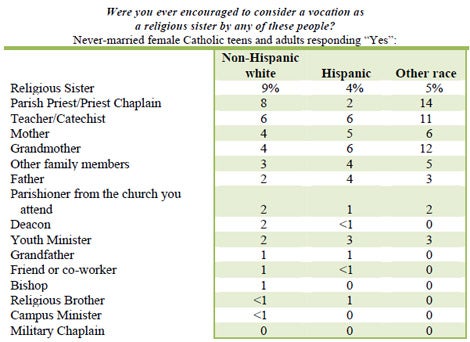
Hispanic female respondents are most likely to say they were encouraged by a grandmother (6 percent), a teacher (6 percent), or their mother (5 percent). Respondents of other races and ethnicities report encouragement most often from a priest (14 percent), grandmother (12 percent), or a teacher (11 percent).
Respondents report an average of 0.4 people that encouraged them. 43 This average is lowest among Hispanic females (0.4 encouragers). By comparison non-Hispanic white females report 0.5 encouragers and those of other races indicate having 0.6 encouragers.
Few female respondents say anyone discouraged them from considering religious life. As the figure on the next page shows, parents and friends are the most common types of individuals to discourage female respondents. Non-Hispanic white females are most likely to report discouragement from their mother (5 percent), Hispanic females from other family members (6 percent), and those of other races and ethnicities from friends or co-workers (8 percent).
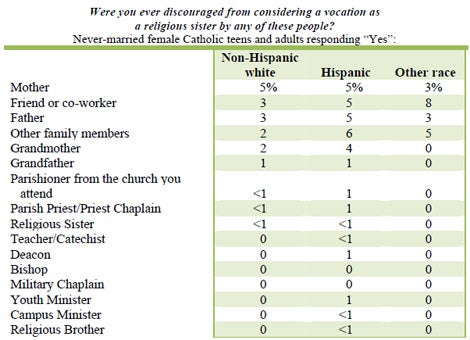
In terms of net encouragement, the results do not vary significantly from overall encouragement with religious sisters, priests, and teachers being most likely to encourage. As with male respondents, the one group with a consistent negative net influence includes friends and co-workers. These results are shown in the table on the next page.
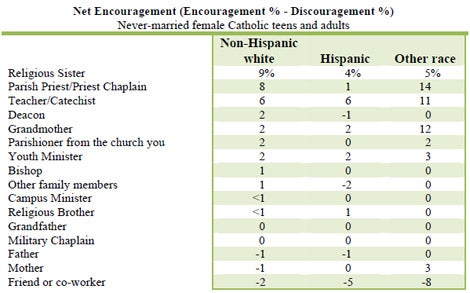
Vocations Presentation Made at School or Parish
Three in ten non-Hispanic white female respondents recall that someone encouraging vocations from a diocese or religious order visited their school or parish. Only 2 percent of non-Hispanic white females say this visit “somewhat” or “very much” made them consider a religious vocation. Respondents of other races and ethnicities are less likely to recall a visit and among those who do, a similar few indicate it encouraged them at least “somewhat” to consider a religious vocation.
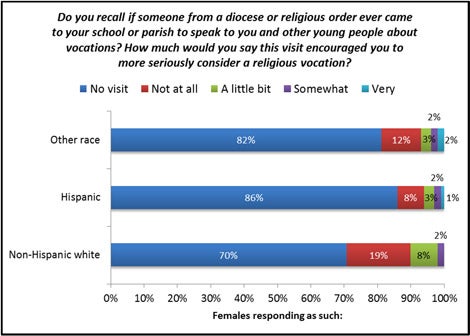
As the figure below shows, having attended a Catholic educational institution significantly increases the likelihood that a female respondent has seen a vocation presentation.
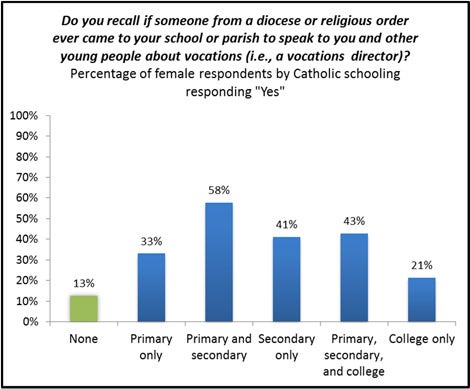
Participation in Church-related Programs, Groups and Activities
Non-Hispanic white females are more likely than others to say they participated in Girl Scouts (40 percent compared to 10 percent of Hispanics and 27 percent of those of other races and ethnicities). Hispanic females are less likely than others to indicate involvement with a parish youth group (16 percent compared to 26 percent of Non-Hispanic whites and 27 percent of those of other races and ethnicities). Few female respondents indicate that they were involved in any of the other Church-related programs, groups, or activities listed.
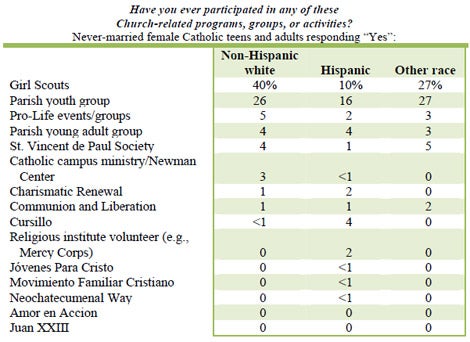
Attitudes about the Church and Vocations
Most female respondents express positive views of religious sisters. About eight in ten or more agree “somewhat” or “very much” that religious sisters do important work. Similar percentages agree that religious sisters are well respected in their community. A majority of female respondents agree “somewhat” or “very much” that they understand what religious sisters do.
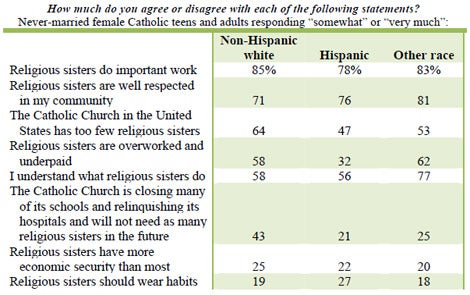
A majority of females, overall, agree at least “somewhat” that the Church in the United States has too few religious sisters. However, just 47 percent of Hispanic female respondents agree with this statement at least “somewhat.” Hispanic respondents are also less likely than others to agree similarly that religious sisters are overworked and underpaid (32 percent). Non-Hispanic white females (43 percent) are most likely to agree at least “somewhat” that the Church is closing schools and relinquishing hospitals and thus will not need as many religious sisters in the future.
Hispanic females are more likely than others to agree “somewhat” or “very much” that religious sisters should wear habits (27 percent compared to 19 percent of non-Hispanic whites and 18 percent of those of other races and ethnicities). Less than one in four overall (22 percent) agree at least “somewhat” that sisters should wear habits.
Consideration of Becoming a Religious Sister
Overall, 10 percent of female respondents say they have considered becoming a religious sister.
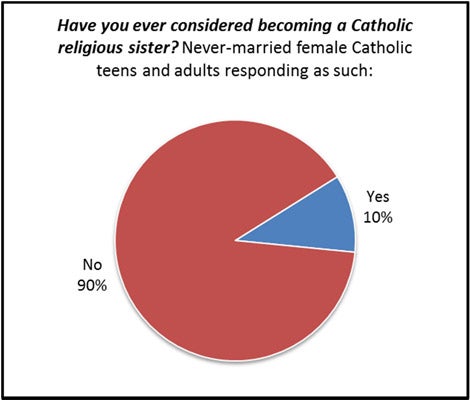
In 2003, when CARA first fielded this question in our national polls, 16 percent of female respondents indicated they had considered becoming a religious sister. A CARA survey in 2008, estimated this to be unchanged at 15 percent. Although the differences between this survey and those of recent years are within margins of sampling error, the pattern over time indicates the possibility that there is a slow erosion of the likelihood of ever having considered a religious vocation among Catholic women in the last decade.44 However, again as noted with male respondents, if this decline is real it is likely related to generational changes with older female Catholics, who may have been more likely to consider this in their youth, gradually being replaced by a younger generation of women who are not equally likely to consider this.
As the first figure on the next page shows, 6 percent of never-married Catholic females say they have “somewhat” or “very” seriously considered becoming a religious sister (2 percent “very” serious only). As the second figure shows, a plurality say they first considered a vocation between the ages of 13 and 18—indicating that the experiences of female Catholics during their secondary school years may be among the most important. However, a third (32 percent) notes they consider this before their teen years, indicating that primary school years may also be important.
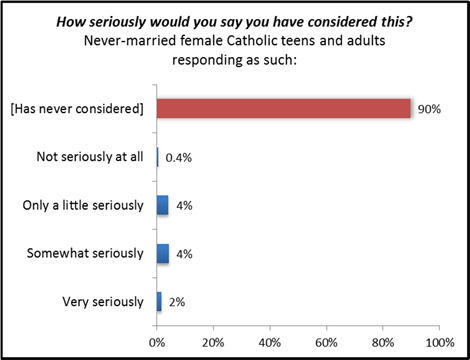
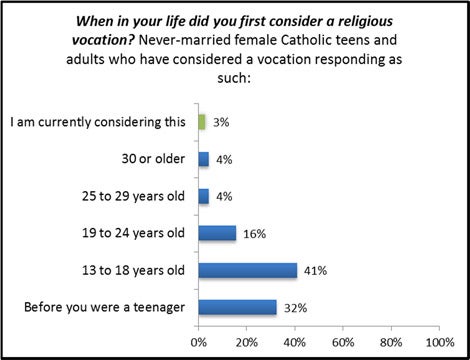
As shown in the figure below, Hispanic and non-Hispanic white females are less likely than those of other races and ethnicities to say they have considered becoming a religious sister. Other race respondents are also more likely than others to say they have considered a vocation at least “somewhat’ seriously (11 percent compared to 5 percent of Non-Hispanic white and Hispanic female respondents).
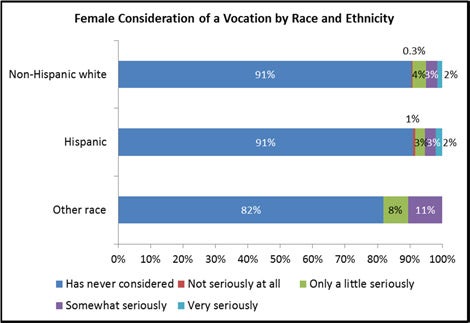
Reasons for Not Considering a Vocation
Respondents who say they have never considered becoming a religious sister were asked, “Why do you think you have never considered this?” as an open-ended question. They could then respond in their own words. CARA categorized the comments in these responses. Overall, female respondents were most likely to reference a general lack of interest, celibacy, not having the calling, or lifestyle issues. Hispanic respondents are more likely than non-Hispanic white respondents to cite general lack of interest (38 percent compared to 28 percent).
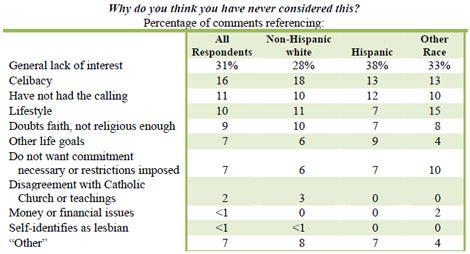
General lack of interest
Three in ten respondents (31 percent) cited a general lack of interest in vocations. Comments representative of this category include:
- Doesn't appeal to me
- Just never thought about it
- Not something I considered
- Not for me
Celibacy
Sixteen percent cite an issue related to celibacy for their lack of consideration. Comments representative of this category include:
- I want to get married and have kids
- I don't think I would ever not be interested in men in a sexual way. I also like flirting and dating them. I like guys too much.
- Yo quise tener hijos.
- I enjoy the company of a man and would like to get married one day
- I like men and having an intimate relationship. I wanted a family, freedom, a career.
- I don't think I could be that celibate
Have not had the calling
One in ten say (11 percent) say they have not felt the calling to be a religious sister. Comments representative of this category include:
- I did not feel that God was calling me to the religious life
- Did not feel I had the calling to serve in that way
- It wasn't my vocation
- It has not been my calling in life
- I never felt called to the sisterhood
Lifestyle
One in ten say (10 percent) say that lifestyle issues are a reason they have not considered a vocation. Comments representative of this category include:
- I couldn't imagine that type of spiritual lifestyle
- There's nothing about the lifestyle of a nun I like
- Lifestyle never appealed to me
- Restricted lifestyle
- Porque no me gusta ser hermana religiosa.
Other reasons
Fewer than one in ten cited other reasons for not considering a vocation, including: doubts about their faith or lack of religiosity (9 percent), having other life goals (7 percent), not wanting to make the commitment necessary or to have restrictions imposed on them (7 percent), disagreements with the Catholic Church or its teachings (2 percent), concerns about money or financial issues (less than 1 percent), or because they self-identify as a lesbian (less than 1 percent). Seven percent provided a response that could not be classified into these other categories and there were not a sufficient number of similar responses to create another category.
Respondents who say they have never considered becoming a religious sister or who have but “not very seriously” were asked what they thought the reasons for this were. Nearly six in ten agreed “somewhat” or “very much” that they want to be a mother (58 percent) or that the lifestyle and work is not what they prefer (58 percent). Similar percentages (57 percent) agree that God is not calling them to a religious vocation or that they have just never really thought about it (56 percent). More agree that they can do God’s will without becoming a religious sister (61 percent).
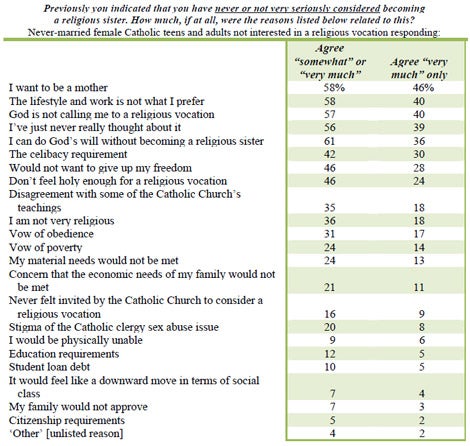
More than four in ten cite the celibacy requirement (42 percent agreeing at least “somewhat” compared to 16 percent noting this in a response to the open-ended question). Nearly half say they don’t want to give up their freedom (46 percent) or that they don’t feel holy enough for a religious vocation (46 percent).
About a third (35 percent) agree at least “somewhat’ that their disagreement with some of the Church’s teachings plays a role in their lack of consideration. One in five (20 percent) agrees similarly that the stigma of the clergy sex abuse issue is a reason for not considering a vocation.45
Only 16 percent agree “somewhat” or “very much” that not feeling invited by the Church to consider a vocation is part of the reason for their lack of consideration. And fewer than one in ten (7 percent) cite similarly concerns about family approval played a role.
Few differences by race and ethnicity are evident. As shown in the figure below, non-Hispanic white females are more likely than others to cite disagreement with Church teachings and celibacy for having not considered a religious vocation.
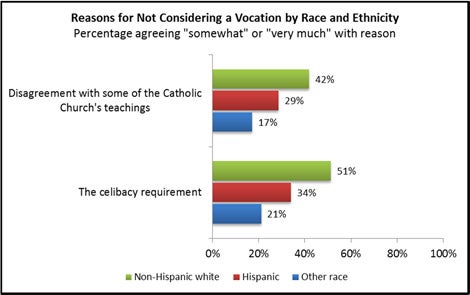
Respondents were asked to select one of the reasons that was most important to their lack of consideration. These are shown below for each race and ethnicity group. Non-Hispanic white and Hispanic females respond similarly selecting their desire to be a mother and that they are not very religious. Respondents of other races and ethnicities indicate they don’t feel holy enough, they are concerned about the economic needs of their family not being met, and that they have just never really thought about it.
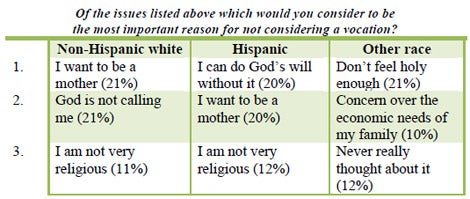
Reasons for Considering a Vocation
Among those females who did say they had considered a religious vocation at least “somewhat’ seriously, the respondents are equally likely to say they did so because of a desire for having an active religious life devoted to ministry and service (77 percent) and a contemplative religious life devoted to prayer and community (79 percent).46

Of those female respondents who have considered a religious vocation, 21 percent indicate that they were considering a vocation for a specific religious order. This represents a small number of respondents overall. However, this small group indicated a diverse number of orders including Benedictine, Dominican, Franciscan, Sisters of Mercy, Sisters of Notre Dame de Namur, Sisters of St. Joseph, and The Little Sisters of the Poor.
Consideration of Becoming a Lay Ecclesial Minister
Female respondents were also asked if they had ever considered becoming a lay ecclesial minister.47 Seven percent of female respondents indicated they had considered this and 1 percent indicated they were already serving the Church in this capacity.48
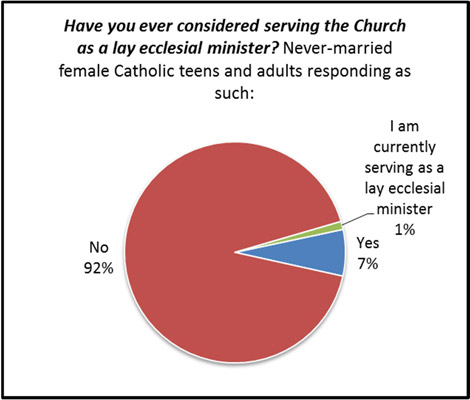
Thus, fewer Catholic females consider becoming a lay ecclesial minister than a religious sister. However, this may be related to the age at which lay ecclesial ministers often report feeling the “first call” to ministry.49
There are no statistically significant differences between racial and ethnic subgroups in consideration of becoming a lay ecclesial minister.
As shown in the figure on the next page, 3 percent of never-married female Catholics say they have “somewhat” or “very” seriously considered becoming a lay ecclesial minister.
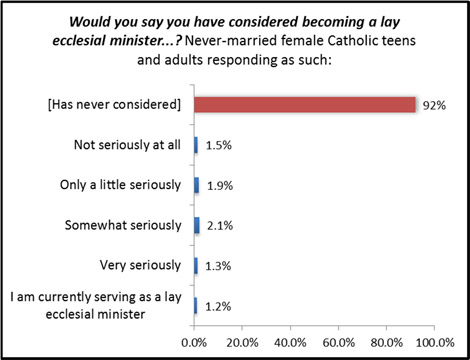
Footnotes
- Thus, female respondents, on average, report fewer people encouraging them than male respondents (o.4 compared to 0.7).
- It is important to note the sample for this survey includes never-married Catholic women, whereas the 2003 and 2008 survey included all Catholic adults.
- None of the responses to the open-ended question referenced the issue of clergy sex abuse.
- After reading the following description: “A lay ecclesial minister is someone with professional training working or volunteering in a ministry at least part-time for a Catholic parish or other Church organization (for example, director of eligious education, pastoral associate, youth minister, campus chaplain, or hospital chaplain).”
- CARA estimates that there are about 38,000 lay ecclesial ministers serving the U.S. Church (Source: The Changing Face of U.S. Catholic Parishes, pg. 60).
- The average age “parish leaders” report first hearing the call is 29 (Source: Perspectives from Parish Leaders: U.S. Parish Life and Ministry, pg. 42).
